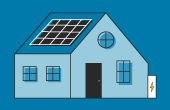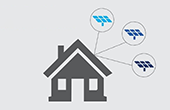Our solar array has significantly reduced our overall energy costs, has allowed us to stop using fossil fuels to heat our home, has allowed us to receive credit from the power company for extra energy generated, and has helped us to get closer to our goal of an all electric home.
$5,300
50% to 74%
of electricity
$25,000
21.2%
Property
- Owner:
- Cliff & Anne B.
- Type:
- Single-Family Residence
- Address:
- Sanford, ME 04073
- Size:
- 2,900 sq ft
- Energy need met:
- 50% to 74% of electricity
- Event Participation:
- NESEA Green Buildings Open House 2013 Host
Technology
- Type:
- Solar PV
- Installed:
- March 2011
- Size of System:
- 8.225 kW
- Monitor performance:
- https://enlighten.enphaseenergy.com/public/systems/6BqZ15132
- Purposes:
- To generate electricity
Financial Details
- Gross Cost of System:
- $39,000
- Value of Rebates:
- $2,000
- Value of Tax Credits:
- $12,500
- Net Cost of System:
- $25,000
- Annual Savings:
- $5,300
- Own or Lease:
- Cash Purchase
- Additional Financial Notes:
- Project was completed in two phases to help manage costs. Maine state solar PV credit was $2000. Fed credits from phase one (30%) were used to purchase addtional panels for phase two.
Professionals & Suppliers
- Installers:
- ReVision Energy
- Energy Auditors:
- Horizon Residential Energy Services Maine LLC
What You Need to Know
Description:
High oil prices in 2008 was the motivation to consider an energy retrofit of the existing building. An energy audit completed in 2008 indicated opportunities to save energy and lower operating costs primarily in the basement and attic areas. Rigid 2" foam panels on walls and spray foam sealing of rim joists along with air sealing completed the basement retrofit. Removal of fiberglass insulation in the attic and adding an R-49 level of loose fill cellulose along with air sealing completed the major audit suggestions. The cold-climate air source heat pump was added in 2008 and replaces oil as the heat source for the residence as well as providing central air cooling. A significant increase in electrical usage from the heat pump prompted the addition of the grid tied solar array in March of 2011, which today totally offsets the heat pump electrical burden. The original system was a grid tied roof mounted array of 23 Conergy 235w panels projected to produce over 6KWHs of power annually. A 30% federal tax crediit helped to finace an additonal 12 Conergy 235w panels. The system utilizes Enphase micro inverters, one under each panel. This system is expected to produce 10,281 kWh of clean, renewable electricity each year, or about 60% of our total energy requirements! A test-out audit was completed in the early summer of 2013 to determine if all the insulating and air sealing work had improved our energy efficiency. It appears our efforts have paid off, and then some, as our house is now considered "too tight" and we have installed a whole-house Energy Recovery Ventilation system to insure proper exchange of the air in the house and address portential air quality and humidity issues. We are able to monitor online how efficiently our systems work. We can pull up information from our solar data monitoring system reading what each panel is generating and also monitor whole house electrical energy usage in real time!
Other Benefits:
A fossil fuel free source of energy for heating, central air, and other electrical needs of the dwelling. Financial credits from the power company, when the array produces more energy than the house requires, means we only pay a power bill 4-5 months/year. Annual energy savings of about $2000/year from solar and about $3700/year from not using oil for heat. Reduces stress on the grid (albiet a minor benfit) when we generate power back to the grid.
Maintenance Requirements:
System is virtually maintenance free; no moving parts. Keeping panels clean (dust, pollen, etc) to improve efficiency of the array. Monitor the output of the array to detect if efficiency is degrading over time or components are failing (automated monitoring implemented).
Efficiency or Sustainability Improvements:
We contracted for an energy audit in 2008. From recommendations, we insulated the full basement walls with 2" rigid insul-board; insulated rim joist cavities with spary foam; air sealed basement ceiling; added 12" celulose insulation to attic (R49); air sealed attic to 1st floor interface; added dryer vent auto-damper vent to reduce infiltration; overall sealing and calking around doors and windows. We installed an air source heat pump in 2008 for heating and cooling. We drive a Hybrid vehicle.
My Motivation:
We wanted to get off fossil fules for heating our house; we wanted to reduce our total cost for energy; do something positive for the environment; reduce our carbon footprint, to have an all electric house.
Advice:
Before you do anything, get an energy audit. It may prevent you from over buying new energy systems or solutions. Be clear and comfortable with why you want to install a clean energy system. Get at least three estimates. Ask a lot of questions. Do your homework. Find a certified installer. Get references. Make sure the final design will meet your expectations. And finally, ask a lot more questions.
Experience with Installer:
Our experience with Revision Energy was a very positive one. They did a site analysis, provided lots of information; answered all our questions; made sure the design would meet our goals; did a quality installation; provided excellent service after the sale; and are generally real nice people to work with. We felt that working with Revision Energy was more like working with a partner than working with a contractor.
Additional Notes:
Our house faces almost exactly due south. Our roof angle was nearly optimal. We had challenges with shade from existing trees that would potentially impact anual output. We removed 9 trees to clear the exposure field for the array while replanting 12 new tress to replace the canopy. Solar PV was an enabler and key to switching from oil heat to heat pump technology. The marriage of Solar PV and Heat Pump technology provided an optimal alternative energy solution.
View Other Case Studies
Search for Other Case StudiesThe EnergySage Marketplace






